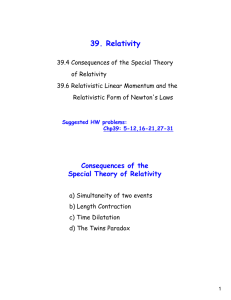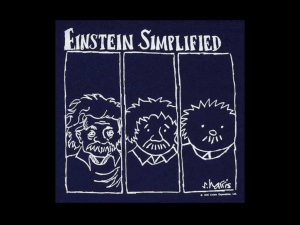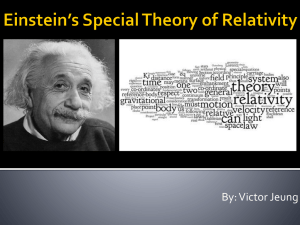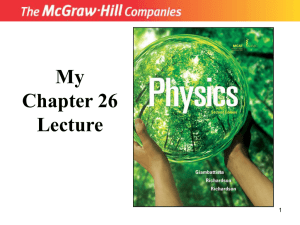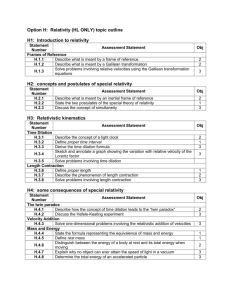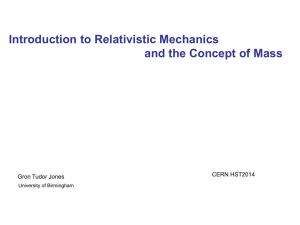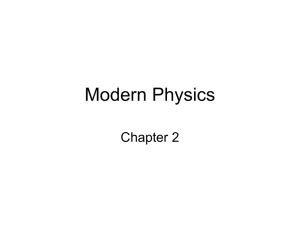29-1 The Postulates of Special Relativity But with light, our
advertisement
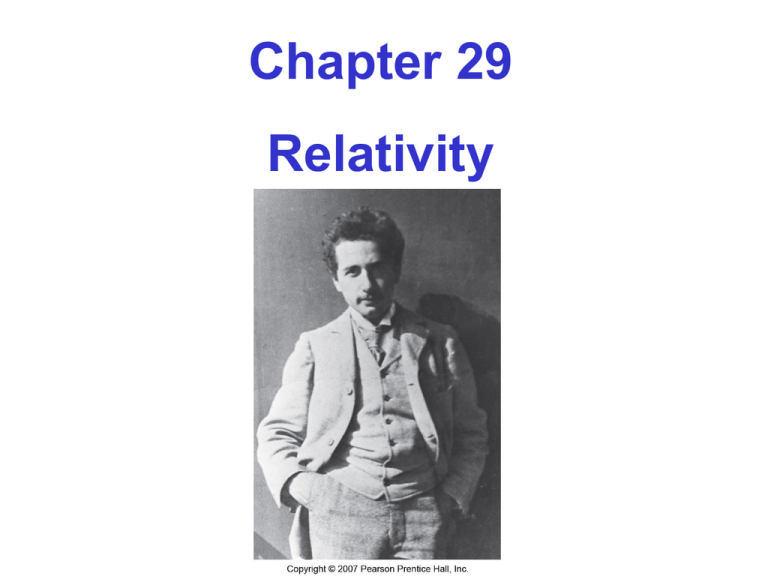
Chapter 29 Relativity 29-1 The Postulates of Special Relativity The postulates of relativity as stated by Einstein: 1. Equivalence of Physical Laws The laws of physics are the same in all inertial frames of reference. 2. Constancy of the Speed of Light The speed of light in a vacuum, c = 3.00 x 108 m/s, is the same in all inertial frames of reference, independent of the motion of the source or the receiver. 29-1 The Postulates of Special Relativity The first postulate is certainly reasonable; it would be hard to discover the laws of physics if it were not true! But why would the speed of light be constant? It was thought that, like all other waves, light propagated as a disturbance in some medium, which was called the ether. The Earth’s motion through the ether should be detectable by experiment. Experiments showed, however, no sign of the ether. 29-1 The Postulates of Special Relativity Other experiments and measurements have been done, verifying that the speed of light is indeed constant in all inertial frames of reference. With water waves, our measurement of the wave speed depends on our speed relative to the water: 29-1 The Postulates of Special Relativity But with light, our measurements of its speed always give the same result: 29-1 The Postulates of Special Relativity The fact that the speed of light is constant also means that nothing can go faster than the speed of light – it is the ultimate speed limit of the universe. 29-2 The Relativity of Time and Time Dilation A moving clock will appear to run slowly. Dt0 is the proper time Dt is the time measured by an observer moving at v Walker 29-10 (a) Suppose you fly on a rocket with a speed v = 0.93c for 2.0 y, according to the ship's clocks and calendars. How much time elapses on Earth during your 2.0 y trip? ans: 5.44 y (b) If you were exactly 22 y old when you left home and your sister was precicely 17, what are your ages when you return? ans: your age 24 y, sister is 22.4 y 29-3 The Relativity of Length and Length Contraction The observer on Earth sees the astronaut’s clock running slow; it takes him 25.6 years to go from Earth to Vega, but only 3.61 years have passed on the astronaut’s clock. 29-3 The Relativity of Length and Length Contraction But how does it appear to the astronaut, who thinks his clock is fine? He sees the distance as contracted instead – for him, Vega is only 3.57 light-years away. 29-3 The Relativity of Length and Length Contraction Proper length, L0: The proper length is the distance between two points as measured by an observer who is at rest with respect to them. So in the above example, 25.3 light-years is the proper length. With some arithmetic, we find: 29-3 The Relativity of Length and Length Contraction Length contraction as a function of v: 29-4 The Relativistic Addition of Velocities Suppose two space ships are heading towards each other, each with a speed of 0.6 c with respect to Earth. How fast do the astronauts in one ship see the other ship approach? It can’t be 1.2 c, but what is it? answer: 0.88c 29-5 Relativistic Momentum If adding more and more energy to a rocket only brings its speed closer and closer to c, how can energy and momentum be conserved? The answer is that momentum is no longer given by p = mv. 29-5 Relativistic Momentum As the speed gets closer and closer to c, the momentum increases without limit; note that the speed must be close to the speed of light before the difference between classical and relativistic momentum is noticeable: 29-6 Relativistic Energy and E = mc2 The rest energy of ordinary objects is immense! In nuclear reactors, only a fraction of a percent of the mass of fuel becomes kinetic energy, but even that is enough to create enormous amounts of power. 29-6 Relativistic Energy and E = mc2 Every elementary particle, such as the electron, has an antiparticle with the same mass but opposite charge. The antiparticle of the electron is called the positron. Mass: Charge: 29-6 Relativistic Energy and E = mc2 When an electron and a positron collide, they completely annihilate each other, emitting only energy in the form of electromagnetic radiation. 29-7 The Relativistic Universe It may seem as though relativity has nothing to do with our daily lives. However, medicine makes use of radioactive materials for imaging and treatment; satellites must take relativistic effects into account in order to function properly; and space exploration would be a disaster if relativistic effects were not handled properly. 29-8 General Relativity This leads to the principle of equivalence: All physical experiments conducted in a uniform gravitational field and in an accelerated frame of reference give identical results. Therefore, the people in the elevators on the previous page cannot, unless they are able to see outside the elevators, tell if they are in a gravitational field or accelerating uniformly. 29-8 General Relativity When the elevator is moving at a constant speed, the light from the flashlight travels in a straight line. When the elevator accelerates, the light bends. 29-8 General Relativity The principle of equivalence then tells us that light should bend in a gravitational field as well. 29-8 General Relativity As light from distant stars passes close to the Sun, it is bent. The result is that an observer on Earth sees the star along a line of sight that is displaced away from the center of the Sun. 29-8 General Relativity If the gravitational field is strong enough, light may be bent so much that it cannot escape. An object that is this dense is called a black hole. Calculations show that the radius of a black hole of a given mass will be: Plugging in the numbers shows us that the Earth would have to have a radius of about 0.9 cm in order to be a black hole. Summary of Chapter 29 • The laws of physics are the same in all inertial frames of reference. • The speed of light in a vacuum is the same in all inertial frames of reference, independent of the motion of the source or the receiver. • Clocks moving with respect to one another keep time at different rates. An observer sees a moving clock running slowly: Summary of Chapter 29 • Length in the direction of motion appears contracted: • Relativistic velocity addition: • It is impossible to increase the speed of an object from less than c to greater than c. Summary of Chapter 29 • Relativistic momentum: Summary of Chapter 29 • For an object of mass M and radius R to be a black hole, its radius must be less than the Schwarzschild radius:

